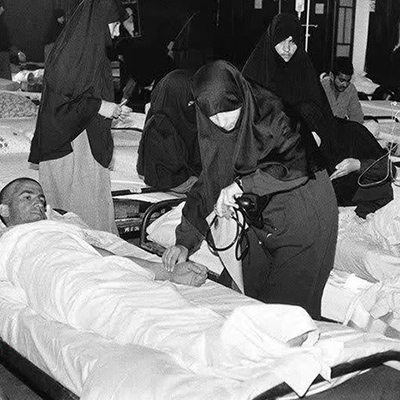Sites
Shahid Kalantari Hospital
Maryam Latifi
95 Views
Located in Andimeshk, close to the Zagros railway lines, Shahid Kalantari Hospital was founded in 1981 to treat war casualties. It remained operational throughout the Iran–Iraq War.
In 1973, the Traverse Company initiated its research and design phase by purchasing land from local farmers to establish a facility for producing concrete railway ties and contributing to the development of the national rail network. Although the project was completed in 1978, its inauguration was postponed due to the occurrence of the Islamic Revolution. Since the production environment was dangerous and accidents were common, an emergency unit of about 1200 square meters was built on the western side of the company premises to treat injured workers.[1]
When the war broke out, many of the wounded were transferred to Andimeshk as it was close to the central frontline, west of the Karkheh River and Shush. The city’s Shahid Beheshti Hospital, however, did not have enough resources and facilities to treat them properly. When Iranian military commanders were planning Operation Fath al-Mubin, it turned out that there should be another hospital in Andimeshk to deal with the increasing number of casualties. As a result, in late 1981, the unused emergency building of the Traverse Company — located near the railway — was handed over to the Islamic Revolutionary Guard Corps (IRGC) for conversion into a hospital. Therefore, Andimeshk IRGC assigned a group of Basij forces, led by Jassem Arab (Hamzeh Tadayyonmanesh), a local IRGC member, to clean the building and check what medical equipment is available.[2] Once the hospital’s needs were listed, the facility was equipped by the medical unit[3] of the Karbala Headquarters.[4] Then, it was named “Shahid Kalantari Hospital” in honor of the late Minister of Roads and Transportation, Mousa Kalantari.[5] Dr. Muhammad-Ali Rahnamoon (martyred) was appointed as the hospital’s director.[6]
Initially, only the emergency section of the Traverse Company was used as a hospital. But over time, with the expansion of the its services, other parts of the company were also put to use. Then, the IRGC constructed an underground concrete emergency unit in the hospital yard, and the national railway company built several shelters on-site.[7]
Shahid Kalantari Hospital included emergency services, a laboratory, internal medicine, surgery, orthopedics, radiology, and a blood bank. It also had support facilities such as a morgue, laundry, prayer room, kitchen, doctors’ dormitory, telecommunication and logistics units, and more.[8]
By 1982–1983, the hospital had 350 inpatient beds, 40 emergency beds, 4 operating rooms, 4 full surgical teams, 1 orthopedic surgeon, 1 vascular surgeon, 8 general physicians, 10 anesthesiology technicians, 18 surgical technicians, 18 lab technicians, 4 radiology technicians, 20 emergency medical technicians, 7 registered nurses, 40 assistant nurses, 30 nurse aides, 80 medics and stretcher-bearers, 1 fully equipped blood bank, 2 helicopter pads, 3 bus ambulances, 2 minibuses, and 8 city ambulances.[9]
At this hospital, many of the staff had come from across Iran, including several nurses and aides from Andimeshk itself. Among them were Dr. Rahnamoon, Dr. Tavana, Dr. Yazdi, and Dr. Zeinab Mina Amiri Moqaddam,[10] alongside nurses and medics like Maryam Katebi, Shamsi Sobhani, Iran Torabi, Atiyeh Chatrchi, Ameneh Daghari, and Soghra Bastak.[11]
In addition, a number of women from Andimeshk volunteered to help out at the hospital. They worked in the laundry and logistics, helped the nurses in caring for the wounded, served meals to the patients, and washed blood-soaked clothes and sheets.[12]
The injured admitted to and treated at this hospital came from western Andimeshk–Dezful axes, Dasht-e Abbas, Fakkeh, Dehloran, Zubeidat, Sharhani, Changuleh, Chenaneh, Ayn-e Khosh, and Reqabiyeh. The hospital also received casualties from Iraqi airstrikes and missile attacks on Andimeshk. Because of its closeness to the southern war zones and its well-connected transportation network, the city received some wounded fighters who were transferred by train and other vehicles. Moreover, the hospital’s two helicopter landing pads helped speed up the transportation of the injured. Patients with less severe injuries were admitted and treated at the hospital, while those in more critical condition were sent to better-equipped hospitals in other provinces with specialized care.[13]
In 1984, the Traverse Company resumed its activity in a separate area within the same compound. When the hospital was overwhelmed with casualties, the company workers helped with unloading the wounded and moving them into the facility.[14]
Despite Andimeshk being bombed several times during the war, Shahid Kalantari Hospital was never directly targeted by Iraqi airstrikes.
The hospital remained active after the war until mid-1998, after which it was officially shut down and its equipment, facilities, and personnel were moved to Shahid Baqaei Hospital in Ahvaz.[15] In 2008, the hospital was registered under code 141 as a National Sacred Defense Heritage Site.[16]
In one part of the “Vilaeeha” movie, women are shown volunteering in the hospital laundry, washing blood-soaked uniforms, sheets, and blankets used by wounded soldiers. The book titled Howz-e Khun by Fatemeh-Sadat Miraali also highlights the efforts of local Andimeshk women volunteering at the Shahid Kalantari Hospital’s laundry. In 2021, the Supreme Leader of Iran wrote a commendatory note praising this book.[17]
[1] Latifi, Maryam. Andimeshk dar Jang-e Araq Alayh-e Iran (Andimeshk in the Iraq-Iran War), Tehran, Niloufaran, 1391, Pp. 221–222.
[2] Ibid.
[3] Ruzname-ye Keyhan (Keyhan Newspaper), No. 20883, 6/7/1393, p. 8.
[4] Latifi, Maryam. Andimeshk dar Jang-e Araq Alayh-e Iran (Andimeshk in the Iraq-Iran War), Pp. 221–222; Darvishi, Muhammad-Sadeq. Behdari-ye Sepah va Jang-e Shimiyaei-ye Araq dar Ayene-ye Asnad-e Jang (Islamic Revolutionary Guard Corps Medical Unit and Iraq’s Chemical War in the Mirror of War Documents), Negin-e Iran, No. 31, Zemestan 1388, p. 100.
[5] Latifi, Maryam. Andimeshk dar Jang-e Araq Alayh-e Iran (Andimeshk in the Iraq-Iran War), p. 222.
[6] Darvishi, Muhammad-Sadeq. Behdari-ye Sepah va Jang-e Shimiyaei-ye Araq dar Ayene-ye Asnad-e Jang (Islamic Revolutionary Guard Corps Medical Unit and Iraq’s Chemical War in the Mirror of War Documents), p. 10.
[7] Latifi, Maryam. Andimeshk dar Jang-e Araq Alayh-e Iran (Andimeshk in the Iraq-Iran War), p. 222.
[8] Ibid., p. 223; Darvishi, Muhammad-Sadeq. Behdari-ye Sepah va Jang-e Shimiyaei-ye Araq dar Ayene-ye Asnad-e Jang (Islamic Revolutionary Guard Corps Medical Unit and Iraq’s Chemical War in the Mirror of War Documents), p. 100.
[9] Darvishi, Muhammad-Sadeq. Behdari-ye Sepah va Jang-e Shimiyaei-ye Araq dar Ayene-ye Asnad-e Jang (Islamic Revolutionary Guard Corps Medical Unit and Iraq’s Chemical War in the Mirror of War Documents), p. 10.
[10] https://www.javann.ir/003fED; https://defapress.ir/fa/news/4081
[11] http://oral-history.ir/?page=post&id=5705; https://www.isna.ir/news/91050301627 ;Anisi, Fariba, Az Khatt-e Kordestan ta Dasht-e Nakhlha-ye Bi Sar (Goftogu) (From the Region of Kurdistan to the Plain of Headless Palms (Interview)), Payam, No. 73, Farvardin 1377, Pp. 4–10; Miraali, Fatemeh-Sadat, Howz-e Khun - Revayat-e Zanan-e Andimeshk az Rakhtshuyi dar Defa Muqaddas (Pond of Blood: Narratives of Andimeshk Women on Washing Clothes during the Sacred Defense), Tehran, Rah Yar, 1399, p. 286; Eslami Pour, Abbas, Hamasei-e Zeynabiyan - Khaterat-e Khaharan-e Andimeshki (Zeynabian Epic: Memoirs of the Andimeshk Women), Tehran, Niloufaran, 1393, p. 32; Nikdel, Samaneh, Nemat Jan - Revayat-e Zendegi-ye Soghra Bastak Emdadgar-e Bimarestan-e Shahid Kalantari-ye Andimeshk (Nemat Jan: The Life Story of Soghra Bastak, Nurse at Shahid Kalantari Hospital of Andimeshk), Tehran, Rah Yar, 1399, p. 104.
[12] Latifi, Maryam. Andimeshk dar Jang-e Araq Alayh-e Iran (Andimeshk in the Iraq-Iran War), p. 223.
[13] Ibid., Pp. 223–224.
[14] Ibid., p. 222.
[15] Ibid., p. 224.
[16] https://www.irna.ir/news/4680109
[17] https://farsi.khamenei.ir/photo-album?id=49793





